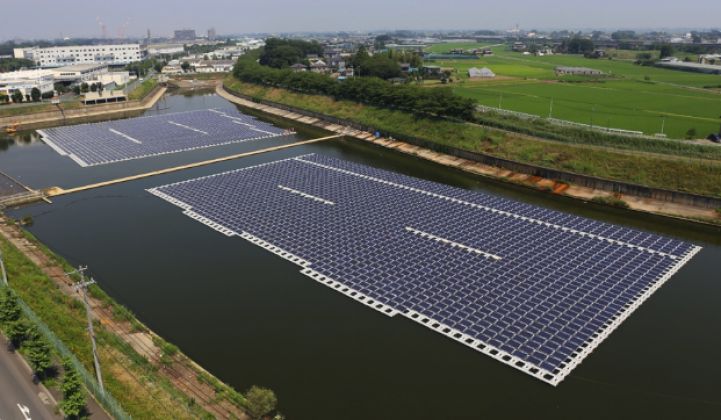Solar PV is rapidly expanding its footprint. Panels are coming to more rooftops, industrial parks, carports and even backpacks. It’s also, increasingly, being installed on top of water.
Kyocera Corporation and Century Tokyo Leasing Corporation announced this week that Kyocera TCL Solar, a joint venture between the two companies, will develop a 13.4-megawatt floating solar power plant in Japan’s Yamakura Dam reservoir near Tokyo. The plant will become the largest floating solar installation in the world.
The project, made up of 50,000 modules, will generate 15,635 megawatt-hours of electricity per year, which is roughly enough to power 4,700 households. Century Tokyo Leasing will provide the project financing and Kyocera Group will supply the solar modules and related equipment in addition to construction, operation and maintenance.
The modules will be installed on patented Hydrelio floating platforms manufactured by the French company Ciel et Terre.
Kyocera aims to bring the plant on-line in March 2016, after negotiating contracts with Tokyo Electric Power Company and others.
Japan is an obvious choice for floating PV because space on land is limited, and there are already lots of inland waterways created for rice agriculture and rainwater control that could be used for solar. Japan also has some of the highest feed-in tariffs in the world. The Japanese government introduced the renewable energy incentives in July 2012 following the Fukushima nuclear disaster.
Last July, Ciel et Terre built Japan’s first floating solar project for PV developer West Holdings, a 1.2-megawatt installation in the city of Okegawa, north of Tokyo. Ciel et Terre has already built or obtained power-purchase agreements for more than ten other floating solar power plants, including in England, India and elsewhere in Japan.
Solar parks on water are also coming to the United States. San Francisco-based Pristine Sun was recently awarded the contract to build a 15-megawatt floating solar project on wastewater treatment pools in Sonoma County, expected to be running by fall 2016. Ciel et Terre is one of several equipment suppliers being considered for the bid. The company has been prequalified to build two other floating solar projects for water agencies in San Diego and Atlantic City, and is awaiting selection.
“In every country, there are large bodies of water for mining, irrigation, aquaculture, chemical plant treatment or wastewater treatment,” said Eva Pauly, international business manager for Ciel et Terre. “When you build solar plants on large bodies of water, you do not [have a] conflict with the usage of the land and…[you] build PV where people consume electricity.”
Installation is also quick and relatively inexpensive, said Pauly, because there’s no need for excavation or a foundation. The floatation structure doesn't need heavy-duty equipment for assembly. Conventional framed solar panels and inverters are then installed on top.
While it’s not usually a good idea to mix electricity and water, the floating systems are proven to be safe. None of the electrical equipment comes in direct contact with water. Every connection between the panels is completely insulated, and the system uses waterproof DC marine cables that have been used for decades in offshore and water treatment work.
The systems aren’t designed for rough, salty offshore conditions, but are able to withstand typhoons and waves over 3 feet high. They’re specifically designed for lakes, reservoirs and other inland water bodies that are close to the grid connection and to areas where the most electricity is consumed.
Floating PV arrays also help to save gallons of water by reducing evaporation and perform more efficiently than ground-mounted systems, thanks to natural cooling from the water. According to Pauly, water agencies are particularly interested in floating PV because many of them have policies to reduce greenhouse gases and a big interest in conserving water, particularly in places like California where there are frequent and severe droughts.
Ciel et Terre isn’t the only company in the floating PV game. For instance, the Australian firm Sunengy has completed a pilot plant with its floating solar collectors in India, and Global Environmental Infrastructure Technology Solutions is developing a floating solar project in Adams County, Wisconsin.
These projects are starting to gain traction because land is at a premium in many countries, or if it’s available, it’s very far away from the load source. Rooftops are also an option, but those solar projects are mostly small-scale, and some roof designs can’t support solar at all.
Floating solar is still more expensive, in general, than ground-mounted PV. Kyocera did not release information about how much the 13.4-megawatt project would cost.
But with three years of testing under its belt, Ciel et Terre has been able to industrialize its floatation technology and prove that it’s bankable. The easy installation process, efficiency benefits and localized manufacturing in France and Japan help to shave costs off of the company’s projects. In Japan, where civil work is expensive because of the need to build earthquake-proof foundations, floating solar is more competitive than ground-mounted systems, said Pauly.
Still, some see the whole endeavor as a way to milk government incentives. When England installed its first floating solar project in August, John Constable, director of the Renewable Energy Foundation, a group critical of subsidies, told The Telegraph the floating solar panels were “an incredibly lucrative way of getting subsidies."
Time will tell if floating solar technology will sink or swim without them.
Correction: In a previous version of this article Ciel et Terre said they were awarded a contract to build a floating solar project in Sonoma Country. However, project developer Pristine Sun has not yet chosen its equipment suppliers.



